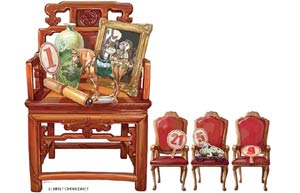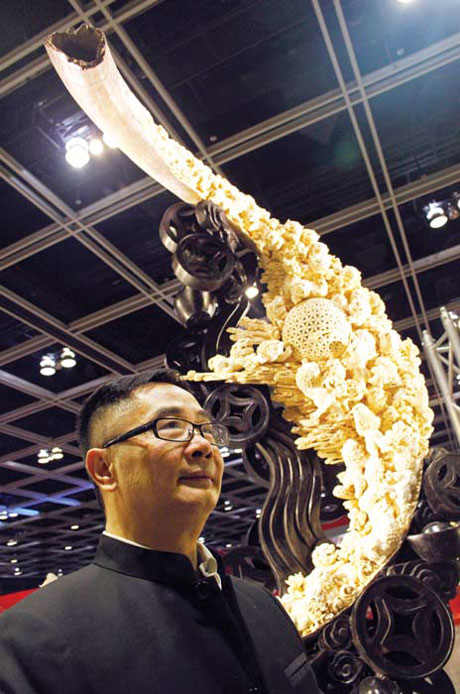Mammoth task to achieve
By Doug Meigs in Hong Kong (China Daily) Updated: 2014-09-01 06:44
|
Master carver Chu poses with one of his mammoth creations. |
Yung Yiu-cheung, 55, inherited this carving technique from his father. The master carver is now passing the Canton ball skills down to his 21-year-old son.
He spoke to China Daily on the sidelines of a panel assessment of Guangzhou's ivory carvers.
Currently working for the Guangzhou Light Industry Group, Yung has layered ball carvings in mammoth and elephant ivory displayed throughout the GZLIG public center in central Guangzhou, Guangdong.
"I'm the fifth generation in my family to carve ivory balls," he says.
"My grandfather made a 26-layer ivory ball and won an award at a World's Fair (at the 1915 Panama-Pacific International Exposition in San Francisco). My dad made a 45-layer one, and he was recognized as a national-level master carver."
Yung himself has carved a 57-layer ball. He has carved the spheres from both mammoth and elephant ivory.
As mammoth tusks are larger than modern elephant tusks, the ball size can be larger. But the aged, brittle material also requires more material between the layers. So, Yung doesn't expect his son to push the family record using mammoth ivory as a medium.
Currently, Yung has access to mammoth ivory and limited amounts of legal elephant ivory for carving through the GZLIG, a member of the national China Arts and Crafts Association.
A manager with GZLIG said the factory is limited to 500 catty (250 kg) per year of elephant ivory from the government's central stockpile, remaining from the 62 tons purchased in a CITES-approved "one-off" sale in 2008. The ivory is restricted for sale within the Chinese mainland and the carved products are forbidden to leave the country.
In the far northeastern city of Harbin, capital of Heilongjiang province, another master ivory carver is continuing to experiment with alternatives to ivory.
Liu Bin is president of the ivory carving industry association, an independent city-level association for both mammoth and elephant ivory craftsmen. Liu began carving mammoth ivory after the ban, too. He claims to be the only national-level master carver in Heilongjiang.
About five years ago, Liu began to apply his ivory carving skills to huge reindeer antlers imported from Russia. He carved into the rough, dark antlers to expose a white, creamy interior.
The resulting piece features carved-out scenes from Journey to the West, Dream of the Red Chamber, and other iconic Chinese stories. To finish the design, he propped each antler carving upon a piece of polished fossilized wood.
The most ornate of the carved antlers was exhibited at the Shanghai World Expo in 2010 and is valued at 689,000 yuan.
"You can see on the surface it's still antler, but the inside is like jade," Liu says, while admiring his design, which his wife carved. "It just shows how we're trying to preserve traditional Chinese ivory carving techniques."
 |
 |
|
|
Putting heart into the art |
- Chinese insurance firms fined $18m for price-fixing
- Liaoning sees 3.4% rise in trade
- Sinopec leads Top 500 Chinese Enterprises list
- Legend Holdings raises millions with partners
- FTZ's platform goes online
- Shanghai shares close at 15mth high
- Guangzhou firm forges Australian link for senior living venture
- China remains world's largest trademark holder


















